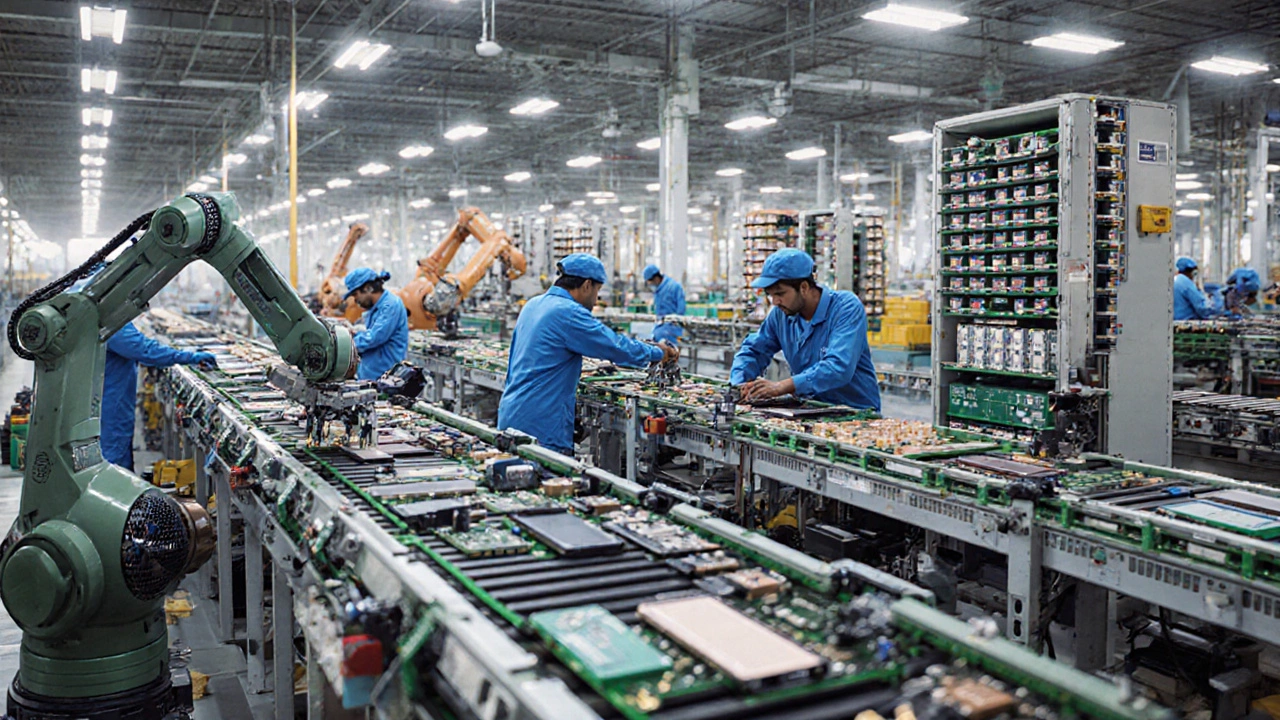
India Electronics Industry Growth Calculator
Industry Growth Analysis
Calculate historical growth rates and project future industry size based on current trends.
Industry Impact Summary
Based on current growth rates, India's electronics industry could reach $300 billion by 2026. This represents a 60% increase from current levels and would position India as a global manufacturing powerhouse.
India's electronics production has grown from $20 billion in 2014 to $180 billion in 2024, with a compound annual growth rate (CAGR) of 24.5%. If this trend continues, India could surpass 50% of China's current electronics production by 2035.
How India Compares Globally
| Country | 2024 Production Value ($B) | Key Products |
|---|---|---|
| India | 180 | Smartphones, TVs, Laptops, Components |
| China | 1200 | Smartphones, PCs, Semiconductors, IoT Devices |
| Vietnam | 45 | Smartphones, Electronics Manufacturing |
| Mexico | 35 | Electronics Manufacturing, Semiconductors |
| South Korea | 28 | Chips, Displays, Advanced Electronics |
Production Linked Incentive (PLI) schemes have boosted India's electronics manufacturing by 30% since 2020. For every $100 million invested in electronics manufacturing, PLI programs have generated:
- 12,000 new jobs
- $50 million in additional exports
- $15 million in value addition
India’s electronics industry isn’t just growing-it’s exploding. In 2024, the country produced over $180 billion worth of electronics, up from just $20 billion in 2014. That’s a ninefold increase in a decade. What used to be a market dependent on imports is now a global manufacturing hub for smartphones, TVs, laptops, and even components like circuit boards and batteries. If you’re wondering how big the electronics industry in India really is, the answer isn’t just numbers-it’s factories, jobs, and a national shift in how the country thinks about making things.
From Importer to Exporter
Just 10 years ago, most electronics sold in India were made overseas. China dominated the supply chain. Today, more than 70% of smartphones sold in India are made here. Brands like Apple, Samsung, and Xiaomi don’t just assemble phones in India-they build entire supply chains here. Foxconn, Pegatron, and Wistron operate massive plants in Tamil Nadu, Uttar Pradesh, and Telangana, turning raw materials into finished devices within weeks.
The shift didn’t happen by accident. Government programs like Production Linked Incentive (PLI) schemes gave companies cash rewards for boosting local output. Apple got $500 million in incentives just for making iPhones in India. By 2025, India is expected to export over $40 billion in electronics, with smartphones making up nearly half of that. That’s more than the entire electronics export value of Brazil, Mexico, and South Korea combined.
What’s Being Made
It’s not just phones. India now manufactures:
- Over 80% of the TVs sold domestically, including 4K and smart models
- More than 30 million laptops and tablets annually
- Basic circuit boards, power adapters, and battery packs
- Medical electronics like pulse oximeters and ECG machines
- Components for electric vehicles, including battery management systems
Even semiconductors, long seen as too complex for India, are starting to change. The government approved $10 billion in funding to build chip plants. Companies like Vedanta and Reliance are building facilities to produce display drivers and power chips. While India won’t make Apple’s A17 chips anytime soon, it’s now making chips for solar inverters, home appliances, and automotive systems.
Who’s Driving the Growth
Foreign companies led the early push. But Indian firms are catching up fast. Companies like Dixon Technologies, Uflex, and Godrej & Boyce are no longer just contract manufacturers-they’re designing products and building brands. Dixon alone employs over 25,000 people across 12 factories and produces more than 100 million mobile devices a year.
Startups are also stepping in. Startups like Locus Robotics and Epiroc are making robotics for electronics assembly. Others are developing software for factory automation. The ecosystem is no longer just about labor-it’s about technology, innovation, and local talent.

Jobs and Infrastructure
More than 3 million people now work directly in India’s electronics manufacturing sector. That’s more than the entire population of countries like Iceland or New Zealand. Most of these jobs are in tier-2 and tier-3 cities like Noida, Tirupati, and Pune, where factories are being built to reduce logistics costs and tap into local talent pools.
Infrastructure has improved too. Special Economic Zones (SEZs) with dedicated power, water, and logistics are now common. The government built 12 electronics manufacturing clusters across the country. One in Chennai has over 50 suppliers under one roof, cutting component delivery time from days to hours.
Challenges Still Remain
But it’s not all smooth sailing. India still imports over 80% of its electronic components. Most circuit boards, memory chips, and sensors come from China, Taiwan, or South Korea. Building a full domestic supply chain will take years. Raw material shortages, inconsistent power supply in some regions, and complex tax rules still slow things down.
Skilled labor is another issue. While there are plenty of factory workers, there’s a shortage of engineers who can design, test, and maintain advanced manufacturing equipment. Training centers are being set up, but it takes time to scale.

What’s Next?
India’s goal is to hit $300 billion in electronics production by 2026. To get there, it needs to move up the value chain. That means making more high-margin products-like medical devices, industrial sensors, and automotive electronics-not just low-cost phones and TVs.
Investors are watching. In 2024, venture capital funding for Indian hardware startups hit $1.2 billion, up 65% from the year before. Global giants like Intel and Texas Instruments are opening R&D centers here. The country is becoming a testbed for new manufacturing models that combine automation with low-cost labor.
If you’re wondering how big the electronics industry in India is, the real answer is: it’s becoming indispensable. It’s no longer just about making things cheaper. It’s about making them smarter, faster, and for the world.
Is India the biggest electronics manufacturer in the world?
No, India is not the biggest electronics manufacturer yet. China still leads with over $1.2 trillion in annual production. Vietnam and Mexico are also growing fast. But India is the fastest-growing major market. In terms of growth rate, India has outpaced all other countries since 2020.
How much of India’s electronics are exported?
In 2024, India exported $40 billion worth of electronics. That’s about 22% of its total production. Major export destinations include the U.S., the U.K., Germany, the UAE, and African nations. Smartphones make up the largest share, followed by TVs, laptops, and components like circuit boards.
What role does the government play in India’s electronics industry?
The government is the biggest catalyst. Through the Production Linked Incentive (PLI) scheme, it offers cash rewards of 4% to 6% on incremental sales for electronics manufacturers. It also funds infrastructure, sets up special zones, and reduces import duties on key components. The National Electronics Policy 2019 set the foundation, and recent updates have expanded incentives to include semiconductors and medical devices.
Are Indian-made electronics reliable?
Yes. Many global brands now make their flagship products in India. Apple’s iPhone 15, Samsung’s Galaxy S24, and Xiaomi’s Redmi series are all produced in Indian factories to the same global quality standards. Independent testing labs in Bengaluru and Hyderabad certify these products before they leave the factory. Quality isn’t the issue-supply chain depth is.
Can India become self-reliant in electronics?
Full self-reliance is unlikely in the next 5-7 years. India will always need to import high-end chips and advanced materials. But the goal is strategic self-reliance: making the bulk of consumer electronics locally, reducing dependence on single countries, and controlling the final assembly and software layers. That’s already happening. By 2030, India could produce 90% of the electronics it consumes.
Final Thoughts
The electronics industry in India isn’t just big-it’s becoming the backbone of its industrial future. It’s creating jobs, attracting global investment, and shifting how the world sees Indian manufacturing. The next decade won’t be about catching up. It’ll be about leading in areas like affordable smart devices, green electronics, and localized supply chains. If you’re watching global manufacturing trends, India is no longer a side note. It’s one of the main players.

